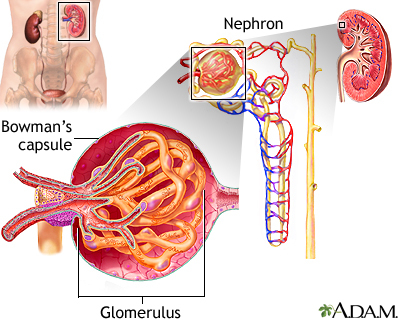Acute nephritic syndrome
Definition
Acute nephritic syndrome is a group of symptoms that occur with some disorders that cause swelling and inflammation of the glomeruli in the kidney, or glomerulonephritis.

Alternative Names
Glomerulonephritis - acute; Acute glomerulonephritis; Nephritis syndrome - acute
Causes
Acute nephritic syndrome is often caused by an immune response triggered by an infection or other disease.
Common causes in children and adolescents include:
- Hemolytic uremic syndrome (disorder that occurs when an infection in the digestive system produces toxic substances that destroy red blood cells and cause kidney injury)
- Henoch-Schönlein purpura (disease that involves purple spots on the skin, joint pain, gastrointestinal problems and glomerulonephritis)
- IgA nephropathy (disorder in which antibodies called IgA build up in kidney tissue)
- Post-streptococcal glomerulonephritis (kidney disorder that occurs after infection with certain strains of streptococcus bacteria)
Common causes in adults include:
- Abdominal abscesses
- Goodpasture syndrome (disorder in which the immune system attacks the glomeruli)
- Hepatitis B or C
- Endocarditis (inflammation of the inside lining of the heart chambers and heart valves caused by a bacterial or fungal infection)
- Membranoproliferative glomerulonephritis (disorder that involves inflammation and changes to kidney cells)
- Rapidly progressive (crescentic) glomerulonephritis (a form of glomerulonephritis that leads to a rapid loss of kidney function)
- Lupus nephritis (kidney complication of systemic lupus erythematosus)
- Vasculitis (inflammation of the blood vessels)
- Viral diseases such as mononucleosis, measles, mumps
The inflammation affects the function of the glomerulus. This is the part of the kidney that filters blood to make urine and remove waste. As a result, blood and protein appear in the urine, and excess fluid builds up in the body.
Swelling of the body occurs when the blood loses a protein called albumin. Albumin keeps fluid in the blood vessels. When it is lost, fluid collects in the body tissues.
Blood loss from the damaged kidney structures leads to blood in the urine.
Symptoms
Common symptoms of nephritic syndrome are:
- Blood in the urine (urine appears dark, tea-colored, or cloudy)
- Decreased urine output (little or no urine may be produced)
- Swelling of the face, eye socket, legs, arms, hands, feet, abdomen, or other areas
- High blood pressure
Other symptoms that may occur include:
- Blurred vision, usually from burst blood vessels in the retina of the eye
- Cough containing mucus or pink, frothy material from fluid buildup in the lungs
- Shortness of breath, from fluid buildup in the lungs
- General ill feeling (malaise), drowsiness, confusion, aches and pains, headache
Symptoms of acute kidney failure or long-term (chronic) kidney disease may develop.
Exams and Tests
During an examination, your health care provider may find the following signs:
- High blood pressure
- Abnormal heart and lung sounds
- Signs of excess fluid (edema) such as swelling in the legs, arms, face, and belly
- Enlarged liver
- Enlarged veins in the neck
Tests that may be done include:
- Blood electrolytes
- Blood urea nitrogen (BUN)
- Creatinine
- Creatinine clearance
- Potassium test
- Protein in the urine
- Urinalysis
A kidney biopsy will show inflammation of the glomeruli, which may indicate the cause of the condition.
Tests to find the cause of acute nephritic syndrome may include:
- ANA titer for lupus
- Antiglomerular basement membrane antibody
- Antineutrophil cytoplasmic antibody for vasculitis (ANCA)
- Blood culture
- Culture of the throat or skin
- Serum complement (C3 and C4)
Treatment
The goal of treatment is to reduce inflammation in the kidney and control high blood pressure. You may need to stay in a hospital to be diagnosed and treated.
Your provider may recommend:
- Bedrest until you feel better with treatment
- A diet that limits salt, fluids, and potassium
- Medicines to control high blood pressure, reduce inflammation, or to remove fluid from your body
- Kidney dialysis, if needed
Outlook (Prognosis)
The outlook depends on the disease that is causing the nephritis. When the condition improves, symptoms of fluid retention (such as swelling and cough) and high blood pressure may go away in 1 or 2 weeks. Urine tests may take months to return to normal.
Children tend to do better than adults and usually recover completely. Only rarely do they develop complications or progress to chronic glomerulonephritis and chronic kidney disease.
Adults do not recover as well or as quickly as children. Although it is unusual for the disease to return, in some adults, the disease does return and they will develop end-stage kidney disease and may need dialysis or a kidney transplant.
When to Contact a Medical Professional
Call your provider if you have symptoms of acute nephritic syndrome.
Prevention
Often, the disorder cannot be prevented, although treatment of illness and infection may help to reduce the risk.
Gallery


References
Radhakrishnan J, Appel GB. Glomerular disorders and nephrotic syndromes. In: Goldman L, Schafer AI, eds. Goldman-Cecil Medicine. 26th ed. Philadelphia, PA: Elsevier; 2020:chap 113.
Saha M, Pendergraft WF, Jennette JC, Falk RJ. Primary glomerular disease. In: Yu ASL, Chertow GM, Luyckx VA, Marsden PA, Skorecki K, Taal MW, eds. Brenner and Rector's The Kidney. 11th ed. Philadelphia, PA: Elsevier; 2020:chap 31.